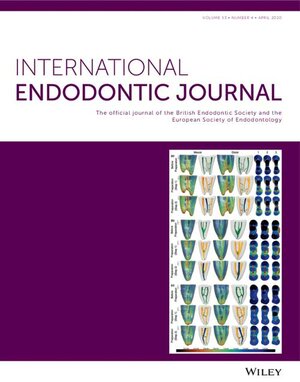FoxO1 mediates odontoblast differentiation of hDPSCs via B cell-derived ANGPTL1 in dental caries: A laboratory investigation
Abstract
Aim
Clinical and in vitro evidence indicates that chronic inflammatory responses initiated by dental caries can persist in the dental pulp even after treatment, necessitating the formation of reparative dentin to restore tissue homeostasis and health. Human dental pulp stem cells (hDPSCs) serve as crucial precursors in this reparative process. This study explores the role of B cells and their secreted factor, Angiopoietin Like 1 (ANGPTL1), in promoting hDPSCs differentiation into odontoblasts under carious conditions, with a particular focus on the activation of Forkhead box O1 (FoxO1).
Methodology
Single-cell RNA sequencing (scRNA-Seq) data from the GEO database were analysed to explore cellular interactions and molecular mechanisms in dental pulp. Immunofluorescence staining was used to investigate the expression patterns of B cells or hDPSCs in dental pulp and hydroxyapatite/tricalcium phosphate (HA/TCP) scaffolds. The expression levels of ANGPTL1 were quantified using enzyme-linked immunosorbent assay (ELISA). Odontoblast differentiation capacity was assessed by alkaline phosphatase activity, alizarin red S staining, and western blotting analysis. hDPSCs were overexpressed or knocked down FoxO1 with lentiviruses. The regulatory interaction between FoxO1 and the DSPP promoter was evaluated through dual-luciferase reporter assay and chromatin immunoprecipitation assay. Statistical analyses were conducted using Student's t-test or one-way analysis of variance (anova) with a p-value of <.05 considered statistically significant.
Results
scRNA-Seq data indicated a significant increase in B cells and ANGPTL1 expression in carious dental pulp. Functional analyses confirmed that ANGPTL1 secreted by B cells activated FoxO1 expression in hDPSCs, enhancing their differentiation into odontoblast-like cells. Blocking ANGPTL1 signalling with a specific antibody reduced FoxO1 expression, indicating a regulatory link between ANGPTL1 and FoxO1. Overexpression of FoxO1 in hDPSCs promoted their differentiation into odontoblasts and facilitated mineralized matrix formation. Mechanistic studies revealed that FoxO1 directly binds to the DSPP promoter, thereby inducing its expression.
Conclusions
Our study reveals a novel mechanism in which ANGPTL1 secreted by B cells in a carious environment promotes the odontoblast differentiation of hDPSCs by upregulating FoxO1. This finding highlights a potential therapeutic target for enhancing dental pulp repair and regeneration.

 求助内容:
求助内容: 应助结果提醒方式:
应助结果提醒方式:


